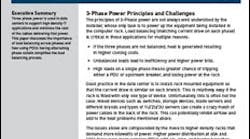Alternating Phase — A New Look at 3-Phase Power Distribution
Three-phase power is used in data centers to support high density IT applications and minimize the cost of the cables delivering that power. This paper discusses the importance of load balancing across phases and how using PDUs having alternating phase outlets simplifies the load balancing process.
The principles of 3-Phase power are not always well understood by the installer, whose only task is to power up the equipment being installed in the computer rack. Load balancing (matching current draw on each phase) is critical in these applications for multiple reasons:
- If the three phases are not balanced, heat is generated resulting in higher cooling costs.
- Unbalanced loads lead to inefficiency and higher power bills.
- High loads on a single phase means greater chance of tripping either a PDU or upstream breaker, and losing power at the rack
The issues above are compounded by the move to higher density racks that demand more kilowatts of power.
Three-Phase power distribution at the rack level traditionally means that power was divided into separate branches. Load balancing and cabling can be difficult. Alternating phased power on a per-receptacle basis provides tangible benefits in the form of simplified cabling, better airflow, better load balancing and greater efficiencies.
This white paper from Server Technology outlines one solution to these issues: using an alternating phase PDU. These specially designed PDUs alternate the phased power on a per-outlet basis instead of a per-branch basis.
